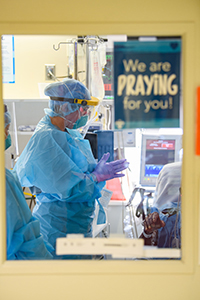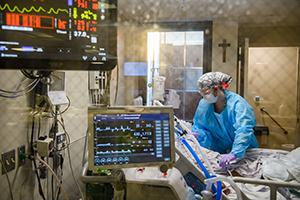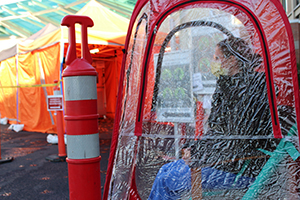By LISA EISENHAUER
August 28, 2020

A clinician in protective gear talks with a patient getting care in a COVID-19 unit at Our Lady of the Lake Regional Medical Center in Baton Rouge, Louisiana.
When Providence St. Joseph Health compiled its latest data on the death rate from COVID-19 in its hospitals in early August, the numbers brought some good news: the rate was down 40% from where it stood after the first three months of the pandemic.
Dr. Joanne Roberts, chief value officer for the 51-hospital system that spans five western states, credits the brighter outcome to the development, communication and use of best practices and protocols. "It's not because patients are younger, although they are younger. Even when we control for that, we're seeing fewer deaths," she says.
"There are certain things we have done across all of our hospitals – proning patients, using high-flow oxygen to keep them off of ventilators as long as possible, the use of (the antiviral) remdesivir, the use of steroids," Roberts said. "I think piece by piece, we're learning a little bit each month to add to the treatment."

A clinician at Our Lady of the Lake Regional Medical Center in Baton Rouge, Louisiana, checks on a patient battling COVID-19.
Across the Catholic health ministry, executives like Roberts say that although the pandemic was only declared in March and the novel coronavirus that causes COVID-19 is still raging, their systems have without a doubt saved lives and helped prevent a worse toll in the communities they serve by quickly adopting new practices and treatment procedures. Markets that experienced early surges shared their experience through informal clinician networks. Systems forged procedures in their own COVID units, they adhered to guidance and guidelines from the Centers for Disease Control and Prevention, and kept close tabs on information published in medical journals.
Increased comfort level
Dr. Catherine O'Neal, chief medical officer for Our Lady of the Lake Regional Medical Center in Baton Rouge, Louisiana, said that by late July, even amid a second upswing in patients with the infection, there was "a lot more comfort with the virus" at her hospital.
Since the start of the pandemic, she said, Our Lady of the Lake's staff have learned many lifesaving lessons, such as:
- How to set up quarantine units for patients who have tested positive for the virus or those suspected of having it.
- When to intubate patients who are in severe respiratory distress or failure. O'Neal said she and her colleagues backed away from advice from care providers in other countries to quickly put COVID patients in respiratory distress on ventilators, opting for other oxygen therapies as first-line treatments.
- What drug regimens to use with high acuity patients and when.
"It took several weeks before the critical care community said no, in fact, not only do we have to treat (COVID patients based on their symptoms) the same way we treat every patient, we have to make sure we do, and we cannot stray from what we know about critically ill patients," she said. "Doing that saved a lot of people's lives and definitely improved recovery rates and got people better quicker."
Managing patient load
Our Lady of the Lake, part of the Franciscan Missionaries of Our Lady Health System, also realized during Louisiana's first COVID surge that the hospital was at risk of being overloaded with patients from congregate care centers such as nursing homes, where the virus seemed to be spreading unchecked.
"We saw that very early on in April," O'Neal recalled. "We had had a very busy day in the emergency department and then suddenly got 10 patients from one nursing home and just became overwhelmed and couldn't catch our breath."

A frontline medical worker at Providence Medford Medical Center in Oregon sits inside an individual isolation tent outside the hospital's emergency department. The tents are where patients wait until they can be screened for COVID-19.
In response, the hospital worked with state health officials to send "strike teams" with infectious disease experts into places like nursing homes and jails to teach the people in charge how to set up isolation units and care in-house for residents and inmates who didn't need hospital treatment. "I think that's just paid huge dividends a couple months down the road," O'Neal said.
Protecting the vulnerable
Dr. William Sistrunk, an infectious disease specialist with Mercy, said that among care providers' key learnings about COVID so far is that the virus takes a harsher toll on certain populations – specifically those who are older and those who have existing health challenges. To save lives, efforts must be focused on keeping the most vulnerable patients from getting infected in the first place, Sistrunk said.
To do that, Mercy has isolated patients with COVID to reduce the contagion risk and has set up separate facilities within communities to test and assess those who might be infected. The health system has worked with local governments and health officials on public information campaigns promoting prevention measures such as masking, social distancing and hand hygiene.
Based in Chesterfield, Missouri, Mercy has 44 hospitals in four Midwestern states. Like other systems, it activated a command center in early March to coordinate its systemwide response. The command center's leaders have used COVID case data and modeling of the virus' projected spread to shift resources as the pandemic has rippled across its system. When the virus appeared in the St. Louis area where Mercy is headquartered, it brought in supplies such as ventilators from its other markets. By mid-summer, Northwest Arkansas was getting slammed, so Mercy sent extra PPE supplies there.
"One of the biggest things I've seen is us mature as an organization to be able to collaboratively work together as a team, as a ministry, to support all of our communities," Sistrunk said.
Virtual expertise
David Erickson, chief medical officer for Avera Health, said the Sioux Falls, South Dakota-based system has decided to keep its incident command center operational until "the pandemic is over, we have a vaccine and people are vaccinated and then we can stand down."
To provide support for clinicians in its rural markets across South Dakota, and in Minnesota and Nebraska, Avera put together a "clinical pearls" team of experienced specialists including critical care and emergency physicians and anesthesiologists. They consult on the care of COVID patients. This allows patients to be treated close to home, reducing the need for transfers to its tertiary care flagship hospital in Sioux Falls, Avera McKennan Hospital and University Health Center.
"We had regular calls with clinicians in all those facilities to share best practices," Erickson said. "We talked about high-flow oxygen, proning, which medications are available, when to use them. We asked that they do virtual infectious disease consults on all those patients who would need to be hospitalized so we could optimize treatment."
The COVID case rate in South Dakota had been mostly level since mid-May but was on a slow rise in August. Erickson said Avera facilities in the state were bracing for a sharper rise due to summer events that went on despite the pandemic, such as fairs and the motorcycle rally that drew tens of thousands to Sturgis from around the nation and inspired the Chicago Sun Time headline: "Harleys everywhere, masks nowhere: Sturgis expects crowd of 250,000."
"We fully expect there will be much more activity probably in the next six to eight weeks," Erickson said in early August.
A common purpose
Like executives at other health systems, Richard DeCarlo, PeaceHealth executive vice president and chief operating officer, said many of the obstacles faced early in the pandemic such as shortages of PPE had proven surmountable by mid-summer. The Vancouver, Washington-based system conducts a daily systemwide video conference to share the latest information on best practices and changes in government guidelines.
DeCarlo said PeaceHealth found that collaborating with other systems improved its ability to deliver care. He became part of a group of executives from five competing hospital networks who speak by phone at least once a week.
"We've been able to share protocols, we've been able to share resources and to really help one another as we've approached this pandemic," DeCarlo said. "It's been a way that we've all come together around a common cause and purpose."
He said PeaceHealth has developed close working relationships with government officials, especially county public health officers, to help in coordinating communitywide responses to stem the spread of the contagion and appropriately respond to outbreaks. When a nursing home in Bellingham, Washington, had an outbreak among residents and staff, the county asked PeaceHealth for help. The system called for members of its staff to work at the nursing home and DeCarlo said 60 people quickly stepped forward.
"I think one of the things that was reinforced for me was just the incredible-mission focused efforts of our care givers rallying … and just stepping up to answer the call," he said.
As pandemic has evolved, systems have stayed nimble in response
Executives at Catholic ministries said that the COVID-19 pandemic has necessitated a quick evolution in treatments and strategies. Every week seems to bring new learnings, they said. These are some of the most important lessons they cited. Their comments have been edited for length and clarity.
Richard DeCarlo, PeaceHealth executive vice president and chief operating officer
One of the things we did was have the physician leaders be the incident commanders. Our chief medical officer was the incident commander and our vice president of medical affairs was the alternate.
Looking back on the last six or seven months, that decision early on was critical, to have the clinical leadership team take responsibility for managing incident command. I think that's what allowed us to focus on protocols and practices — which were very clinically driven — being led by the physician leaders and other clinicians of our health system.
Dr. David Erickson, chief medical officer for Avera Health
When we came out of the gate, it was just a sprint. We were working seven days a week nonstop and we hit a point where people were starting to get fatigued so we went to some mandatory paid time off and this summer we've encouraged folks to unplug and to take some time off to recharge as we kind of get ready for the fall with the river rising again. That was an important learning for me.
Dr. Catherine O'Neal, chief medical officer for Our Lady of the Lake Regional Medical Center in Baton Rouge, Louisiana
You have to put a multidisciplinary team together right away and make sure that everybody has a plan and treats everybody the same. Protocols for everything from assessment to admission to treatment to discharge are the only way to get through this.
You can't catch up once your emergency room's exploding and you can't find a bed in the hospital. That's not the time to get everybody together and say: What's going to be our level of oxygen that we admit into the (intensive care) unit? What's going to be the level that we keep on the floor?
Dr. Joanne Roberts, chief value officer for Providence
The time for virtual medical care has arrived and we're not going back. We don't know exactly what that's going to look like but I think we can expect maybe a quarter to two-thirds of all office visits will be done virtually going forward.
Dr. William Sistrunk, an infectious disease specialist with Mercy
I've seen people within Mercy just go out of their way to try to help other communities (within Mercy). I think we've grown as an organization from the leaders down in understanding how we can help each other.
Copyright © 2020 by the Catholic Health Association
of the United States
For reprint permission, contact Betty Crosby or call (314) 253-3490.